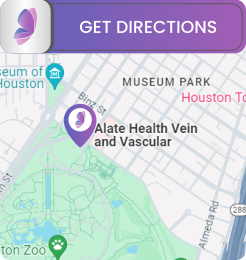Port and PICC Placement Treatment Specialist in Houston TX
Port and PICC placement provide reliable, long-term access to the bloodstream for delivering vital treatments, eliminating the need for frequent, painful needle sticks. A Port is surgically implanted entirely under the skin for discreet, years-long access, while a Peripherally Inserted Central Catheter (PICC) is a non-surgical line ideal for shorter therapies lasting weeks to months. Both procedures significantly enhance patient comfort throughout a course of treatment. Visit Dr. Andrew Doe, MD, at Alate Health. For more information, contact us today or book an appointment online now. We are conveniently located at 1213 Hermann Dr Suite 255, Houston, TX 77004.


Table of Contents:
What is the procedure for PICC line placement like?
What is the difference between a PICC line and a port?
How long can a port or PICC line stay in place?
Where is the ideal placement for a PICC?
Achieve Confidence in Your Treatment with Dr. Andrew Doe’s Port & PICC Placement at Alate Health
Why Choose Our Port & PICC Services?
A PICC line is a long, thin tube placed into a vein in your arm to deliver medications, nutrition, or fluids directly into a large vein near your heart. This is often recommended for patients who require long-term intravenous therapy.
• Our Approach: The highly trained interventional radiologists at Alate Health perform PICC line placement using the latest imaging technology to ensure maximum accuracy and comfort. Your safety and well-being are our top priorities throughout every step of your care.
What to Expect:
• Consultation & Consent: Before your procedure, our team will explain the process in detail, answer your questions, and ask you to sign a consent form.
• Preparation: You’ll be made comfortable on a procedure table with your arm gently extended. The insertion area will be thoroughly cleaned and covered with a sterile drape to minimize infection risk.
• Local Anesthesia: We use local anesthetic to numb the insertion site, so you should experience little to no discomfort.
• Precision Placement: Using ultrasound guidance, your radiologist will identify the best vein in your upper arm. The PICC line is then carefully threaded through your vein to a large vein near your heart.
• Imaging Confirmation: After placement, we use advanced imaging—such as a chest X-ray—to confirm that your PICC line is perfectly positioned.
• Completion: The line is secured with a sterile dressing and, if needed, a stabilizing device. Our staff will provide thorough aftercare instructions, including how to care for your PICC line, signs of potential complications, and when to contact us for help.
The entire PICC line placement process at Alate Health typically takes 30 to 60 minutes, and most patients are able to use their arm gently soon after the procedure.
A PICC line—peripherally inserted central catheter—is a long, thin tube that our interventional radiologists insert through a vein in your upper arm. Under precise image guidance, the catheter is advanced to a large vein near your heart. The end of the PICC line remains outside your body, making it easy for our team and your other healthcare providers to deliver medications, fluids, or nutrition, or to draw blood. PICC lines are an excellent option for patients needing intravenous (IV) therapy for weeks or months. At Alate Health, we perform PICC insertions using minimally invasive techniques for your comfort and safety, and provide detailed instructions for care and maintenance.
In contrast, a port—sometimes called an implanted port or port-a-cath—is a small medical device that our specialists implant entirely beneath the skin, usually in the chest area. The port is connected to a catheter that leads directly into a large vein near the heart. Because the port is placed under the skin, there is no external tubing, making it more discreet and often more comfortable for long-term use. Ports are ideal for patients who require repeated intravenous treatments, such as chemotherapy, over several months or even years. Our team uses advanced imaging and minimally invasive techniques to ensure your port is placed safely and efficiently, with minimal downtime and scarring.
• Implanted Ports (Port-a-Cath):
A port is a small medical device that is surgically placed under the skin, usually in the chest. It is designed for long-term use and can remain in place for months or even years, provided it is functioning well and free of complications such as infection, blockage, or clotting. At Alate Health, our interventional radiologists use advanced imaging guidance to ensure precise placement and optimal function of your port. Ports are ideal for patients who need ongoing access to their veins, and our team provides comprehensive care, including monitoring and prompt management of any issues.
• PICC Lines:
A PICC line is a thin, flexible tube inserted into a vein in the arm and advanced to a larger vein near the heart. PICC lines are generally intended for intermediate-term use, typically remaining in place for several weeks to a few months. With proper care, some PICC lines can stay in place for up to a year. Our clinic offers expert placement and ongoing assessment of PICC lines, with a focus on minimizing risks such as infection or blockage. Regular follow-up at Alate Health ensures your PICC line remains safe and effective throughout your treatment.
Both ports and PICC lines require routine evaluation by experienced healthcare professionals. We are committed to providing thorough monitoring and swift intervention if complications arise, such as signs of infection or device malfunction. When your treatment is complete or if your medical needs change, our team will help determine the appropriate timing for safe removal or replacement of your device.
The ideal position for a PICC line tip is in the lower third of the superior vena cava, just above the right atrium of the heart. Placing the catheter tip in this location is essential for optimal dilution of medications and fluids, which minimizes the risk of vessel irritation or thrombosis.
Our interventional radiologists utilize advanced imaging techniques—such as real-time ultrasound guidance for venous access and fluoroscopy or chest X-ray for tip confirmation—to ensure accurate placement. Typically, the PICC is inserted through a peripheral vein in the upper arm, such as the basilic, cephalic, or brachial vein, and then carefully advanced to the central circulation.
Correct placement of the PICC line is critical to reduce potential complications, including arrhythmias, thrombosis, or ineffective therapy delivery. We are committed to providing expert, image-guided PICC line placements that support the best possible outcomes for our patients requiring long-term intravenous therapy.
Dr. Andrew Doe, MD, is a board-certified interventional radiologist and founder of Alate Health Interventional Radiology in Houston, TX. With deep expertise in vascular access procedures, Dr. Doe and his team offer specialized Port and PICC line placements to provide safe, long-term intravenous access without frequent needle sticks.
• Personalized Access Options: Dr. Doe helps you choose between port vs. PICC based on your treatment needs, duration, and lifestyle.
• Precision & Safety: Using imaging guidance and sterile technique to ensure the line is placed accurately and with minimal risk.
• Comfort-Focused Process: The procedure is performed in a controlled outpatient environment, aiming for minimal discomfort and fast recovery.
• Comprehensive Follow-Up: After placement, Dr. Doe and his team monitor the access line’s function, manage any complications, and guide maintenance.
• Transparent & Trustworthy Care: Alate Health strives for clear communication and patient education throughout the treatment journey.
With Dr. Andrew Doe leading the care, patients receive the support and expertise they need for a reliable, long-lasting vascular access solution — whether for chemotherapy, antibiotics, nutrition, or long-term IV therapy. For more information, contact us today or book an appointment online now. We are conveniently located at 1213 Hermann Dr Suite 255, Houston, TX 77004. We serve patients from Houston TX, Bellaire TX, Jacinto City TX, Spring Valley Village TX, Stafford TX, Bunker Hill Village TX, and surrounding cities.

Additional Services You May Need
▸ Adenomyosis
▸ Enlarged Prostate
▸ Leg Ulcers
▸ Joint Pain
▸ Varicose Veins
▸ Uterine Fibroids
▸ Pelvic Congestion
▸ Vascular Malformations
▸ Dialysis/Renal Failure
▸ Port and PICC Placements
▸ Peripheral Arterial Disease
▸ Primary and Metastatic Liver Cancers
▸ Hemorrhoid Artery Embolization (HAE)







